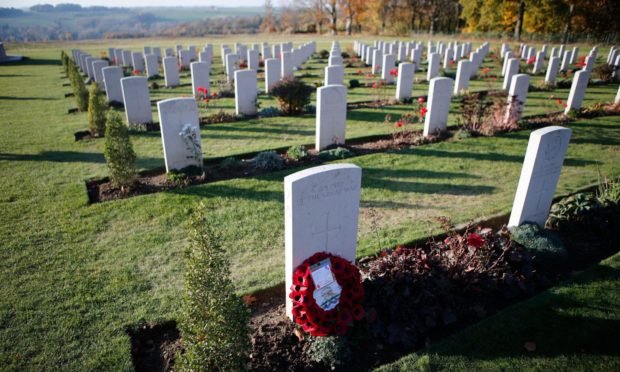A recent report from the Commonwealth War Graves Commission is a timely counter to suggestions that historians and others are overly focused on negative aspects of Britain’s imperial past.
Prime Minister Boris Johnson may want an end to what he calls “cringing embarrassment about our history“. But War Graves Commission research has uncovered much to be embarrassed about.
Analysis of the means by which this country constructed its empire has concentrated of late on the way that Britain’s rise to global supremacy was fuelled by involvement in slavery and slave trading – the enduring legacy of this involvement being underlined, just this week in The Press & Journal, by the revelation that the Dick Bequest (a longstanding source of charitable funding for schools and school teachers in Scotland’s north-east) owes its existence to its founder, having profited from his trafficking of human beings.
Racist thinking was not eliminated by the outlawing of slavery
Britain, to be sure, abolished slavery throughout the empire in 1834 and afterwards took a leading role in efforts to suppress the continuing sale of enslaved Africans to countries like the United States, where slavery endured into the 1860s.
But the racist thinking that underpinned the slave trade – thinking embodied in the notion that Africans were inherently inferior to Europeans – was in no way eliminated by slavery’s outlawing. That’s made all too clear by the findings of the committee the War Graves Commission set up to investigate what the commission calls “historical inequalities in commemoration”.
Britain was long inclined to treat dismissively people who, despite their homelands having been made British by means of conquest and annexation, were afterwards drawn into the British Empire’s worldwide military machine
All such inequalities, it’s recognised, are wholly at odds with values adopted when, in the later stages of the First World War, the commission – then the Imperial War Graves Commission – was founded to provide burial places for soldiers and sailors killed during the four years it took the British Empire to win its war with Kaiser Wilhelm’s Germany and its allies.
Second World War dead, too, would be entrusted to the War Graves Commission’s care. And central to its remit from the outset, the commission stressed in its response to its own committee’s enquiry into failings first uncovered by historians and TV documentary makers, was “the principle of equality of treatment in death” – a principle meant to ensure “that whatever an individual’s rank in social or military life, their treatment in the grave would be the same”.
Hence the creation of those hauntingly beautiful and always immaculately kept military cemeteries, where row upon row of identical gravestones mark the last resting places of the men and women those same gravestones name, honour and commemorate.
Hundreds of thousands of Asian and Black soldiers were not commemorated
Now, however, it has been recognised that, in the First World War’s aftermath, this principle of equality of treatment in death was not extended to huge numbers – perhaps several hundred thousand – of military personnel drawn from Britain’s African and Asian colonies. Many of them have not been commemorated by name. Many have never been commemorated at all.
While shocking from today’s perspective, discrimination of this kind is arguably of a piece with the dismissive way Britain was long inclined to treat people who, despite their homelands having been made British by means of conquest and annexation, were afterwards drawn into the British Empire’s worldwide military machine.
Our shared duty is to honour and remember all those, wherever they lived and whatever their background, who laid down their lives for our freedoms at the moment of greatest peril.
My statement on the Commonwealth War Graves Commission report. pic.twitter.com/ft6LxGzGPh
— Boris Johnson (@BorisJohnson) April 22, 2021
Something of this is evident in the beginnings of our own Highland regiments. The Jacobite Highlanders who confronted the British army at Culloden in 1746 might have been dismissed as “savages” and worse by their opponents. But to one such opponent, Colonel James Wolfe, Highlanders seemed a potential resource.
“They are hardy, intrepid, accustomed to rough country, and no great mischief if they fall,” he commented. Highlanders, in other words, were expendable.
Not many years later, Wolfe, now a general, would command the Highland troops – lots of former Jacobites among them – who, by storming Quebec, made Canada British instead of French.
Colonial troops were expendable to Britain
But if Highland soldiers were (to begin with anyway) expendable, they were also white and so could be fully integrated into Britain’s imperial forces. That didn’t happen to Indian, African and other colonial troops, either in life or in death.
“The average native,” one colonial governor informed the Imperial War Graves Commission, “would not understand or appreciate a headstone.”
In “entrenched prejudices, preconceptions and pervasive racism” of this sort, today’s commission recognises, are to be found the reasons for the failure to give the empire’s African and Asian war dead the respect accorded automatically to their white comrades.
At this remove, it will be difficult – perhaps in some cases impossible – to retrieve the names of men consigned to unmarked graves. But the task, the War Graves Commission stresses, will be attempted. And not before time.
Jim Hunter is a historian, award-winning author and Emeritus Professor of History at the University of the Highlands and Islands

